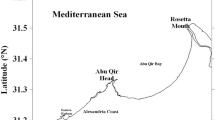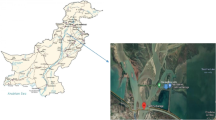Abstract
Bioaccumulation of heavy metals and analysis of mineral element alongside proximate composition were studied in tissues of freshwater mussels (Anodonta anatina) exposed to various doses of Pb, Cu and Cr in water. The concentrations of all the studied heavy metals in soft tissues of the mussels increased as the metal doses were increased from 0 to 360 µg/L of water. The highest concentration of Cu was observed in the gills of mussels at the highest dose (360 µg/L), whereas the lowest concentration was observed in the Cr-exposed mussels at lower dose (120 µg/L). Amongst mineral elements, Ca was found to be the most abundant element in all tissues. The maximum Ca (156,906 ± 736 mg/kg) was observed in the gills. The abundance order of the other mineral elements was P > Mn > Na > K > Zn. Proximate analysis showed that the protein (15.45 ± 1.13 %), fat (0.97 ± 0.10 %) and moisture (77.78 ± 1.20 %) contents were significantly higher in the foot, whereas the carbohydrate (15.15 ± 1.30 %) and ash (10.55 ± 1.11 %) contents were higher in the mantle and gills, respectively. It was found that the low-dose exposure of Pb and Cu and the high-dose exposure of Cr caused higher protein content in the foot. It appears that freshwater mussels (Anodonta anatina) are an essential tool for biomonitoring studies. However, specific evaluation of mussel tissues was more effective than using the whole animal in these studies.






Similar content being viewed by others
References
AOAC (1997) Official methods of analysis (16th ed. Arlington, USA: Association of Official Analytical Chemists International Publ (pp. 1179). Arlington, USA: Association of Official Analytical Chemists International Publ
AOAC (2000) Official method of analytical chemists, 17th edn. Association of Official Analytical Chemists, Maryland
Baraj B, Niencheski LF, Corradi C (2003) Trace metal content trend of mussel Perna perna (Linnaeus, 1758) from the Atlantic Coast of Southern Brazil. Water Air Soil Pollut 145:205–214
Berrahal AA, Lasram M, El Elj N, Kerkeni A, Gharbi N, El-Fazaa S (2011) Effect of age-dependent exposure to lead on hepatotoxicity and nephrotoxicity in male rats. Environ Toxicol 26:68–78
Blackmore G, Wang WX (2003) Comparison of metal accumulation in mussels at different local and global scales. Environ Toxicol Chem 22:388–395
Boening DW (1999) An evaluation of bivalves as biomonitors of heavy metals pollution in marine waters. Environ Monit Assess 55:459–470
Burlando B, Bonomo M, Capri F, Mancinelli G, Pons G, Viarengo A (2004) Different effects of Hg2+ and Cu2+ on mussel (Mytilus galloprovincialis) plasma membrane Ca2+ -ATPase: Hg2+ induction of protein expression. Comparative Biochemistry and Physiology Part C: Toxicol Pharmacol 139:201–207
Cantillo AY (1998) Comparison of results of mussel watch programs of the United States and France with worldwide mussel watch studies. Mar Pollut Bull 36:712–717
Chandurvelan R, Marsden ID, Gaw S, Glover CN (2012) Impairment of green lipped mussel (Perna canaliculus) physiology by waterborne cadmium: relationship to tissue bioaccumulation and effect of exposure duration. Aquat Toxicol 124:114–124
Ersoy B, Sereflisan H (2010) The proximate composition and fatty acid profiles of edible parts of two freshwater mussels. Turk J Fish Aquat Sci 10:71–74
Espana MA, Rodriguez ER, Romero CD (2007) Comparison of mineral and trace element concentrations in two molluscs from the Strait of Magellan (Chile). J Food Compo Anal 20:273–279
Fernandez-Reiriz MJ, Labarta U, Babarro JM (1996) Comparative allometries in growth and chemical composition of mussel (Mytilus galloprovincialis Lmk) cultured in two zones in the Riasada (Galicia, NW Spain). J Shellfish Res 15:349–353
Fuentes A, Fernandez-Segovia I, Escriche I, Serra JA (2009) Comparison of physico-chemical parameters and composition of mussels (Mytilus galloprovincialis Lmk.) from different Spanish origins. Food Chem 112:295–302
Goldberg ED (1986) The mussel watch concept. Environ Monit Assess 7:91–103
Grienke U, Silke J, Tasdemir D (2014) Bioactive compounds from marine mussels and their effects on human health. Food Chem 142:48–60
Guidi P, Frenzilli G, Benedetti M, Bernardeschi M, Falleni A, Fattorini D, Nigro M (2010) Antioxidant, genotoxic and lysosomal biomarkers in the freshwater bivalve (Unio pictorum) transplanted in a metal polluted river basin. Aquat Toxicol 100:75–83
Jones WG, Walker KF (1979) Accumulation of iron, manganese, zinc and cadmium by the Australian freshwater mussel Velesunio ambiguus (Phillipi) and its potential as a biological monitor. Mar Freshw Res 30:741–751
Karakoltsidis PA, Zotos A, Constantinides SM (1995) Composition of the commercially important Mediterranean finfish, crustaceans, and molluscs. J Food Comp Anal 8:258–273
Karnjanapratum S, Benjakul S, Kishimura H, Tsai YH (2013) Chemical compositions and nutritional value of Asian hard clam (Meretrix lusoria) from the coast of Andaman Sea. Food Chem 141:4138–4145
Kimbrough KL, Lauenstein GG, Christensen JD, Apeti DA (2008) An assessment of two decades of contaminant monitoring in the Nation’s Coastal Zone
King I, Childs MT, Dorsett C, Ostrander JG, Monsen ER (1990) Shellfish: proximate composition, minerals, fatty acids, and sterols. J Am Diet Assoc 90:677–685
Labrot F, Narbonne JF, Ville P, Saint Denis M, Ribera D (1999) Acute toxicity, toxicokinetics, and tissue target of lead and uranium in the clam Corbicula fluminea and the worm Eisenia fetida: comparison with the fish Brachydanio rerio. Arch Environ Contam Toxicol 36:167–178
Maanan M (2007) Biomonitoring of heavy metals using Mytilus galloprovincialis in Safi coastal waters, Morocco. Environ Toxicol 22:525–531
Mosher S, Cope WG, Weber FX, Shea D, Kwak TJ (2012) Effects of lead on Na+, K+-ATPase and hemolymph ion concentrations in the freshwater mussel Elliptio complanata. Environ Toxicol 27:268–276
Orban E, Di Lena G, Nevigato T, Casini I, Marzetti A, Caproni R (2002) Seasonal changes in meat content, condition index and chemical composition of mussels (Mytilus galloprovincialis) cultured in two different Italian sites. Food Chem 77:57–65
Orban E, Di Lena G, Nevigato T, Casini I, Caproni R, Santaroni G, Giulini G (2006) Nutritional and commercial quality of the striped venus clam, Chameleagallina, from the Adriatic sea. Food Chem 101:1063–1070
Patel B, Anthony K (1991) Uptake of cadmium in tropical marine lamellibranchs, and effects on physiological behaviour. Mar Biol 108:457–470
Pogoda B, Buck BH, Saborowski R, Hagen W (2013) Biochemical and elemental composition of the offshore-cultivated oysters Ostrea edulis and Crassostrea gigas. Aquaculture 400:53–60
Rahnama R, Javanshir A, Mashinchian A (2010) The effects of lead bioaccumulation on filtration rate of zebra mussel (Dreissena polymorpha) from Anzali wetland–Caspian Sea. Toxicol Environ Chem 92:107–114
Sarkar SK, Cabral H, Chatterjee M, Cardoso I, Bhattacharya AK, Satpathy KK, Alam MA (2008) Biomonitoring of heavy metals using the bivalve molluscs in Sunderban mangrove wetland, northeast coast of Bay of Bengal (India): possible risks to human health. CLEAN Soil Air Water 36:187–194
Sasikumar G, Krishnakumar PK, Bhat GS (2006) Monitoring trace metal contaminants in green mussel, Perna viridis from the coastal waters of Karnataka, southwest coast of India. Arch Environ Contam Toxicol 51:206–214
Tessier APGC, Campbell PGC, Auclair JC, Bisson M (1984) Relationships between the partitioning of trace metals in sediments and their accumulation in the tissues of the freshwater mollusc Elliptio complanata in a mining area. Can J Fish Aquat Sci 41:1463–1472
Turkmen M, Turkmen A, Tepe Y, Ates A, Gokkus K (2008) Determination of metal contaminations in sea foods from Marmara, Aegean and Mediterranean seas: twelve fish species. Food Chem 108:794–800
Usero J, Morillo J, Gracia I (2005) Heavy metal concentrations in molluscs from the Atlantic coast of southern Spain. Chemosphere 59:1175–1181
Viarengo A, Canesi L (1991) Mussels as biological indicators of pollution. Aquaculture 94:225–243
Viarengo A, Pertic M, Mancinelli G, Burlando B, Canesi L, Orunesu M (1996) In vivo effects of copper on the calcium homeostasis mechanisms of mussel gill cell plasma membranes. Comparative Biochemistry and Physiology Part C: Pharmacol Toxicolo Endocrinol 113:421–425
Vincent-Hubert F, Arini A, Gourlay-France C (2011) Early genotoxic effects in gill cells and haemocytes of Dreissena polymorpha exposed to cadmium, B [a] P and a combination of B [a] P and Cd. Toxicol Environ Mutagen/Mutat Res 723:26–35
Wadige CPM, Taylor AM, Maher WA, Ubrihien RP, Krikowa F (2014) Effects of lead-spiked sediments on freshwater bivalve, Hyridella australis: linking organism metal exposure–dose-response. Aquat Toxicol 149:83–93
Yap CK, Ismail A, Tan SG, Omar H (2003) Accumulation, depuration and distribution of cadmium and zinc in the green-lipped mussel Perna viridis (Linnaeus) under laboratory conditions. Hydrobiol 498:151–160
Yap CK, Ismail A, Tan SG (2004) Heavy metal (Cd, Cu, Pb and Zn) concentrations in the green-lipped mussel Perna viridis (Linnaeus) collected from some wild and aquacultural sites in the west coast of Peninsular Malaysia. Food Chem 84:569–575
Yap CK, Ismail A, Ismail AR, Tan SG (2006) Biomonitoring of ambient concentrations of cadmium, copper, lead and zinc in the coastal wetland water by using gills of the green-lipped mussel Perna viridis.4:247–252
Zhou Q, Zhang J, Fu J, Shi J, Jiang G (2008) Biomonitoring: an appealing tool for assessment of metal pollution in the aquatic ecosystem. Anal Chim Acta 606:135–150
Acknowledgments
This work was funded by the Higher Education Commission Pakistan (HEC) for their International Research Support Initiative Program that enabled the first author to conduct part of this research at the School of Agriculture, Food and Rural Development, Newcastle University, UK.
Author information
Authors and Affiliations
Corresponding author
Electronic supplementary material
Below is the link to the electronic supplementary material.
Rights and permissions
About this article
Cite this article
Sohail, M., Khan, M.N., Chaudhry, A.S. et al. Bioaccumulation of heavy metals and analysis of mineral element alongside proximate composition in foot, gills and mantle of freshwater mussels (Anodonta anatina). Rend. Fis. Acc. Lincei 27, 687–696 (2016). https://doi.org/10.1007/s12210-016-0551-5
Received:
Accepted:
Published:
Issue Date:
DOI: https://doi.org/10.1007/s12210-016-0551-5




